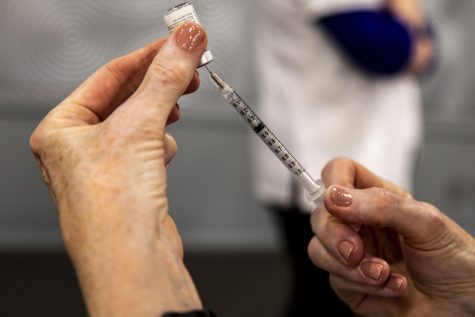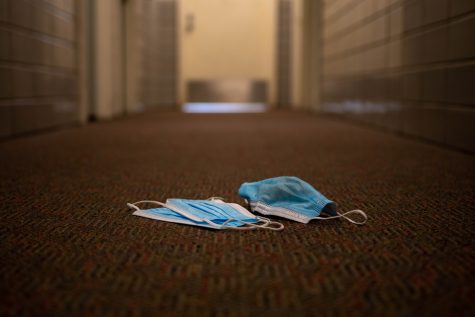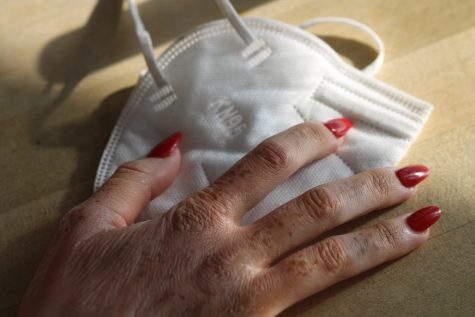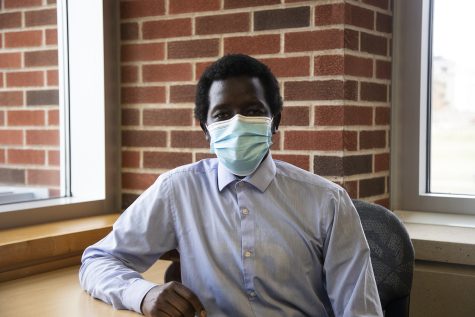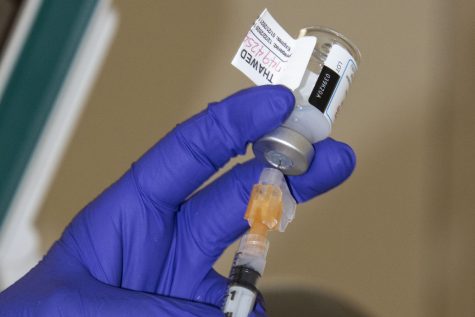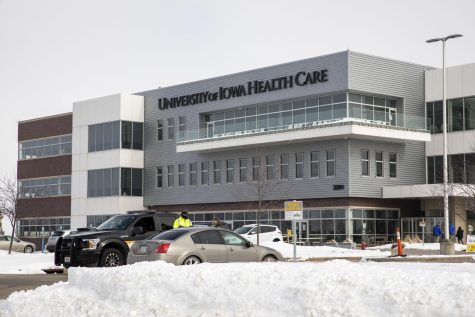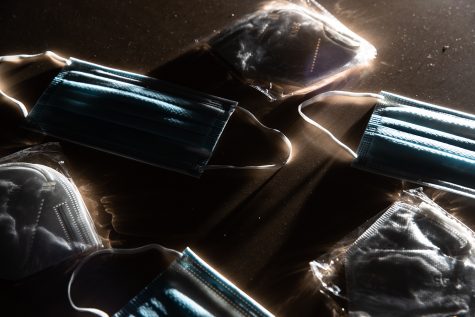Public health experts encourage second dose in face of Delta variant
While Johnson County has a moderate rate of transmission, surrounding counties, especially in rural areas, are at higher risk to transmit the Delta variant.
U of Iowa students given first round of vaccinations on Thursday, Jan 28, 2021. A medical student receives the Moderna vaccine.
August 4, 2021
Thousands of Iowans continue to go without the second shot in the two-dose COVID-19 vaccines, creating challenges for residents during the rise of the Delta variant.
According to the Iowa Department of Public Health, 58.6 percent of Johnson County residents and 46.9 percent of Iowans are fully vaccinated. As of Aug. 2 103,691 people in Iowa have initiated, but not completed, a two-dose COVID-19 vaccine series according to the Iowa Department of Public Health.
In the 18 to 30-year-old age group, the vaccination rate is less than 50 percent in Johnson County, Christine Petersen, director of the center for emerging infectious diseases and professor in the department of epidemiology at the University of Iowa College of Public Health, said.
With these numbers, public health experts in Johnson County, such as Community Health Manager Sam Jarvis, are calling on residents to reduce transmission rates by getting their second dose of two-dose vaccines.
“We hope that everyone recognizes the importance of finishing their two-dose series,” Jarvis said. “The intention is that you will get the full effectiveness that the vaccine provides — only getting one shot doesn’t allow you that benefit.”
The first dose of the COVID-19 vaccine provides some protection, but the second dose allows the body to create more and stronger antibodies, UI Carver College of Medicine Executive Dean Pat Winokur said.
The second dose improves the antibody response by about 10 to 20 times, she said. This is important because the response to the vaccine drops about six percent every two to three months and having more antibodies provides protection for longer, she added.
According to the Centers for Disease Control and Prevention, Moderna requires a four-week wait period and Pfizer requires a three-week wait period between the two doses of the COVID-19 vaccine. The CDC recommends people receive the second dose of their vaccine as close to this interval as possible, but the second dose should be given up to six weeks after the first.
Even with this window, it’s never too late to get the second dose, Winokur said. The second dose improves a person’s immune response, which is crucial during the pandemic, she said.
RELATED: Local and state health officials urge Iowans to get vaccinated as Delta variant gains strength
As previously reported by *The Daily Iowan*, the Delta variant has been on the rise in Iowa since it was detected by the State Hygienic Lab on May 4.
The Delta variant is different because it has certain mutations that allow it to bind better to cells more quickly and pass between them more rapidly, Winokur said.
“With the Delta variant, when people talk or cough, they expel more virus particles that can then become contagious to the next person,” Winokur said. “Because they tend to be able to gain entry pretty quickly, we’ve found that this is a pretty transmissible virus.”
Public health officials are concerned about the Delta variant because people who are vaccinated can become infected, Jarvis said.
“With this variant, we’re hearing that persons who are fully vaccinated may become infected after being exposed,” Jarvis said. “Persons who are vaccinated may become mildly ill, but they might be able to infect others and put people who aren’t vaccinated at risk.”
Petersen said the Delta variant could create more mutations, which is concerning.
“The longer we have people in crowds who aren’t vaccinated with people who are vaccinated, the more we are increasing the odds of them creating another variant,” Petersen said. “If we get a variant that the vaccine doesn’t protect against, we are back to last year’s closures, lockdowns, and overrun hospitals.”
Petersen said the only way to stop COVID-19 from mutating is protecting new people from getting infected and people from getting infected again, as that can allow the virus to learn how to beat the vaccine.
Despite these findings, the COVID-19 vaccines are effective at preventing infections in all strains of the virus, Winokur said.
She said the vaccine is 60 to 70 percent effective at preventing asymptomatic disease and prevents severe disease and hospitalizations for all discovered strains of the virus.
“The vaccine is one of the best weapons we have to protect ourselves against this virus,” Winokur said. “I’ve been very impressed with how effective the vaccines remain, even though we’ve gone through quite a number of different variants.”
RELATED: UI researchers’ survey highlights adolescent, parent concern about COVID-19 vaccine
Another way for people to protect themselves against the Delta variant is to return to wearing masks, Jarvis said.
On July 27, the CDC changed their mask guidance for fully vaccinated people in areas that have substantial or high rates of transmission to return to wearing masks indoors. This doesn’t currently apply to Johnson County, which has a moderate rate of transmission as of July 31.
Other counties are suffering with substantial and high rates of community transmission, including Linn, Cedar, and Muscatine — neighboring Johnson County.
“It’s important as people go about their lives, visit friends and family, and travel for work to note this,” Jarvis said. “They may be going to an area of high transmission, which is good information to have to protect yourself.”
Johnson County is the most vaccinated county in Iowa, but students returning this fall might change that, Petersen said.
“Right now, as a community we are doing fairly well,” Petersen said. “The challenge is in two weeks when we start seeing a steady stream of students coming from other, less vaccinated counties, which may lead to more social gatherings with people who’ve been exposed to lots of different viruses.”
As people prepare for the fall and a potential fourth wave of the virus, it’s important for everyone to talk about getting vaccinated with the people they trust, Jarvis said.
“It’s hard to determine where we’ll go in the coming weeks to months, but we are monitoring that closely,” Jarvis said. “We’re not making the progress that we’d like to see, and it will depend on our community and the communities around us to recognize that the most effective way to stop this pandemic is to get vaccinated.”





